
Brian Cuerrier of Belleville, ON uses the windlass to race at the Quebec Cup regatta in Pointe Claire Quebec with companion Emilie Léonard in 2015. Photo: Luka Bartulovic
Innovations in sailing technology
A slick white hull cuts through the salt waters just outside the Northwest Arm, a narrow inlet off Halifax, Nova Scotia. The 16-foot sailboat weaves nimbly through whitecapped crests and powers through relentless grey swells.
Kevin Penny is used to the choppy sea state and blustery winds in this gateway to the Atlantic. He’s been sailing on these waters for almost 20 years and knows just how the wind will bend around McNab Island or flutter along Herring Cove. Penny’s eyes scan the water for dark patches that will betray incoming gusts, then he shifts his gaze back up to the sails. A quick mental calculation and he takes a decisive inhale on a small white straw perched just below his mouth. The boat’s 2 sails respond in tandem by squeezing in a few inches tighter. He grins as the boat tilts and the ocean sprays mist over the hull.
Despite the gusty breeze, Penny is in full control of the little sailboat, and loving every minute. Penny also happens to be sailing the boat using only his breath.
The power of adaptation
Quadriplegic since his teens, Penny explains, “I have no movement from my chest down, so I am not able to sail the boat ‘traditionally.’ So, I use what’s called ‘sip and puff’.”
When he’s out on the water, Penny sits in the boat’s narrow cockpit, motionless except for subtle, precise head movements between 2 white tubes that extend from a small fitting in the pocket of his weatherbeaten lifejacket. The tubes look like regular drinking straws that would be at home in a juice box, and the scene can be puzzling at first.
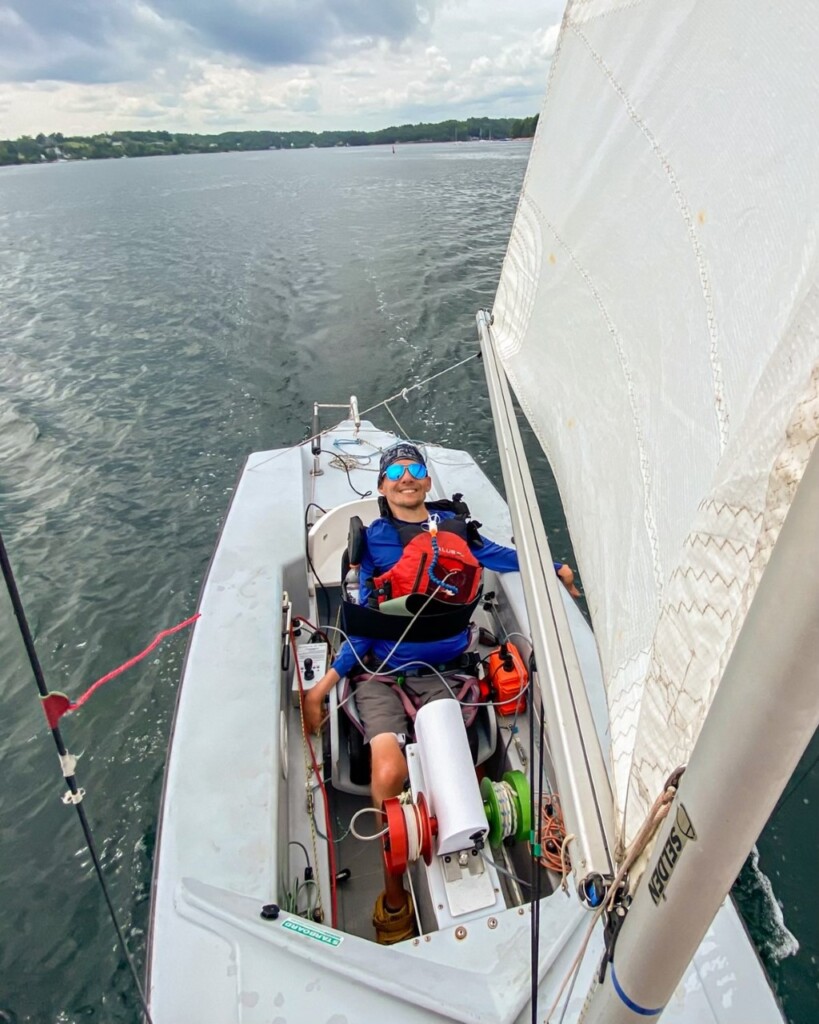
“I have 2 straws that I can blow and suck on, and one will allow me to [control the sails], and then the other one will allow me to steer to port or starboard,” says Penny.
“The way I’m able to make it all happen is just with my breath.”
What Penny is accomplishing with his breath is a remarkable testament to the power of technology in sport. To understand the impact of this specialized equipment, it’s helpful to understand what must take place when it’s not there.
Sailing
In its simplest form, a sailboat needs 2 things to sail: power to move forward and steering to control direction.
Power comes from the sails that harness the wind. Depending on the strength and direction of the breeze, and the sailor’s desired path, ropes attached to the sails (termed “sheets” in sailing speak) are loosened or tightened accordingly to optimize the sails’ power.
The steering comes from the rudder at the back of the boat. The rudder, which looks like a long fin or blade, sits below the water, and is attached to the hull by hinges that allow it to pivot. To move the rudder left or right, a sailor typically pushes or pulls a lever attached to it known as a “tiller.”
In conventional sailboat set ups, managing the sails and rudder takes a good deal of physical effort. While physiological demands vary greatly depending on the discipline of boat, studies have found that sailing demands high levels of flexibility, power, aerobic and anaerobic capacity as well as hand-eye coordination and agility.
At first glance, sailing might not seem very welcoming to participants like Penny. Until what’s known as the Power-Assist System is added to the equation.
Unlocking access: The Power-Assist system
Designed by Canadian Steve Alvey in 1994, the Power-Assist was conceived with an extremely specific goal in mind. Alvey’s vision, as he told Canadian Boating magazine at the time, was to develop a sailing system for “quadriplegic sailors that would enable [them] to sail solo without outside assistance.”
The vision became a reality that has since opened up sailing to a wide spectrum of athletes who otherwise might never have accessed the sport.
“There about 20 ‘Able Sail’ or ‘adaptive sailing’ programs across Canada. As far as I know, almost all of them have Power-Assist equipment,” says Paula Stone, accessible sailing advocate and founding partner at KAPE Boatworks, the Ontario-based company that builds one of the most popular accessible sailboats in Canada, the Martin 16.
“There are many sailors who are using the […] technology.”
Designing for inclusion
So just what is this technology that’s unlocking access to the water for so many?
“The configuration on the boat is there’s a piece of technology called a ‘windlass,’ which allows me to [pull] in and out the sails,” Penny explains. “Then there’s a piston that’s connected to the [rudder at] back of the boat that allows me to steer.”
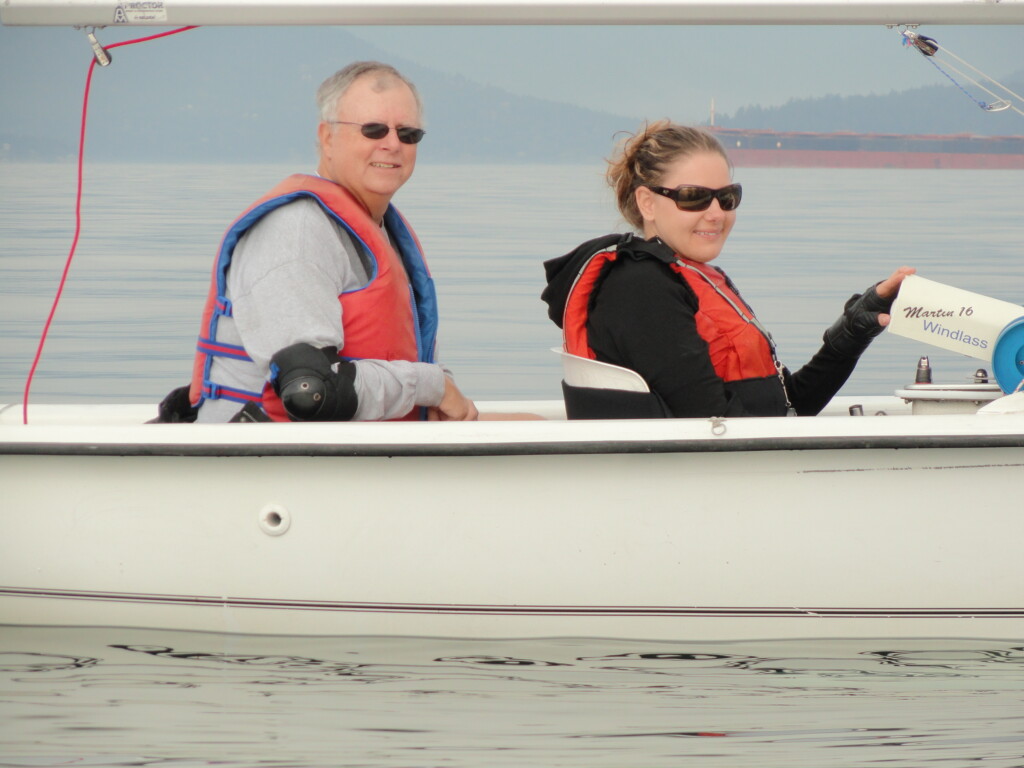
The last piece of the puzzle is the autohelm control unit, essentially the brains of the operation. The autohelm unit is about the size of a shoebox, with a small joystick mounted on top and 2 short tubes protruding to attach the sip and puff straws. The battery-powered unit links to the windlass and piston by simple cable connectors and can activate either one at the sailor’s command.
Sailors have several options to control the system: using a rocker switch on the windlass for the sails, the joystick on the autohelm unit for sails and/or rudder, or like Penny, the sip and puff straws. The sip and puff controls were a game changer for Penny, who previously had few options to be active.
“I’m a big sports guy, but I never really had the chance to actually be involved, and sailing was the one that gave that to me.”
The entire system is portable, modular, and can be used in a variety of combinations. Penny believes the technology makes sailing “the most adaptable sport there is. People have so many different cool setups.”
The options to choose which, if any, of the Power-Assist components to use mean individual sailors can customize their controls.
“Some people might be able to steer on their own, but they need [the Power-Assist] if they don’t have the upper body strength to be able to sheet [control the sails], and other people might just need it for steering,” Penny explains.
“It’s whatever works for them. And that’s what’s the cool thing about it.”
Customizing for performance
Sara Lambert is one of those sailors who has dialled in her Power-Assist set up to suit her sailing needs and goals. Soft spoken and quick witted, the Calgary-based engineer is a regular, and competitive, fixture on the Martin 16 regatta circuit with her boat, Prairie Schooner. Sailing wasn’t always a good match though.
Growing up in Manitoba, Lambert took lessons at the local sailing school, but found the conventional boats didn’t always align with the impact of her neuromuscular disability.
“Some of my challenges have always been with movement,” she shared, “even at a young age, [I was] always trying to find ways to cut corners, and my moving from one side of the boat to the other wasn’t enjoyable.”
Lambert, who uses a power wheelchair for mobility, ended what she calls her “non-accessible sailing career” at a young age and thought the sport just wasn’t an option. Things changed in 2005 when she tried the accessible Martin 16 sailboat. With a forward-facing cockpit, there’s no need to scramble from side to side during maneuvers like the boats of her childhood lessons. Lambert has now been sailing and racing for almost 20 years, experimenting with her control set up as she goes.
She describes those first few forays into accessible sailing as “kind of casual, out for a cruise type of thing,” noting, “at that point, I had no [Power-Assist] equipment.”
Over time, Lambert became more serious about racing. As she increasingly pushed her limits in stronger winds and steeper waves, she began to see the possibilities of the technology.
“I remember the practice day at my first Mobility Cup [international regatta]. It was such a different experience sailing on the ocean compared to Calgary’s reservoir. While Calgary can be quite gusty, the consistent strength of the ocean’s wind and waves pushed the limits of my physical strength. Steering became much more difficult in the higher wind.”
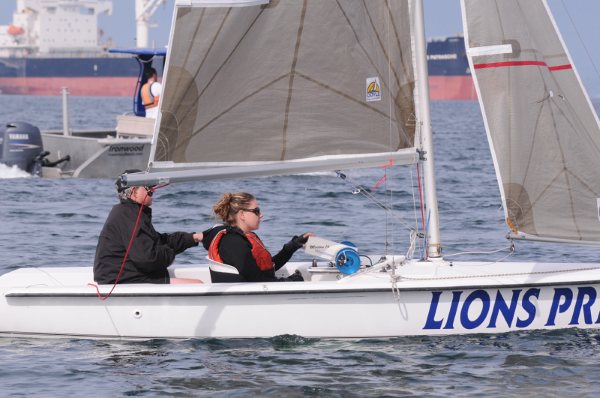
Lambert began exploring Power-Assist options, gradually adding equipment.
“I had added the windlass earlier on, and then when higher winds became an issue, I added in the auto-helm steering component,” she says.
“[It was] progressive, I started with no controls, then moved to a windlass with manual steering. And then after that moved to electronic steering.”
The flexibility of the configuration means that the sport can adapt along with the sailor, even if their disability fluctuates or progresses.
“[This equipment] is also great for kids with disabilities to get in and learn what they can do,” explains Stone, who, in addition to manufacturing accessible boats, was an occupational therapist for 36 years and has recommended sailing to countless clients of all ages.
“It’s a sport that will grow with them. Even if the child has a degenerative condition. They’ll always be able to sail.”
In Lambert’s case, the equipment has helped manage the physical demands of sailing, but she also likes customizing her set up for optimal efficiency on the racecourse. She keeps one hand on the windlass, using a switch to control the sails, and her other hand on the joystick for steering, rather than using the joystick for both.
When it comes to the equipment, “there’s so many permutations,” she muses, “a different permutation is I like to have the differentiation between the [sails and steering]. It’s like another gradation, actually.”
The Power-Assist equipment has helped Lambert reach many goals on the racecourse, but she still appreciates that the technology brings recreation to life too.
“I always feel lucky that I have sailing as a sport. I like that you can either just go for that Sunday cruise, just go out and [sail] around on a sunny breezy day,” she smiles, “or you can have this really structured, competitive environment. And it’s fun to have access to both.”
Looking beyond the horizon
BC-based sailor Gerry Burns loves that versatility as well. A retired pro motocross racer and ultimate surfer dude, Burns got hooked on sailing 13 years ago at the accessible sailing program on Jericho Beach in Vancouver.
“[Sailing] seriously has the intensity and the aggressiveness of motocross, you’ve got 20 boats ripping into the first corner, and no one’s letting off!” he exclaims.
But he loves the Zen of the sport, too.
“When you’re out there on the water you’ve got the beauty and the sounds of the waves, the rush of moving fast on the water — and it can be wild or peaceful. It’s so much like surfing actually, I couldn’t believe how it actually combines my two favourite sports.”
Like Lambert and Penny, the technology available in sailing was what made the sport the right fit for him.
“My condition’s a little unique, even though I’m a high level, incomplete quadriplegic, I have pretty good mobility in my right side, then, almost no movement in my left,” he explains. In the early years after his injury, “there weren’t many adapted sports that actually worked for me physically.”
Then he came across an article about sailing in a magazine about disabilities, and Burns, who has been known to take on any adventure that comes his way, thought, why not?
“I just thought, you know what? This is something new, and I was always up to try anything […] I wanted to at least give [sailing] a try and see it, then it blew my mind. It changed my life.”
Given his strength in one hand, the Power-Assist is ideal for him to use his right hand for the joystick control.
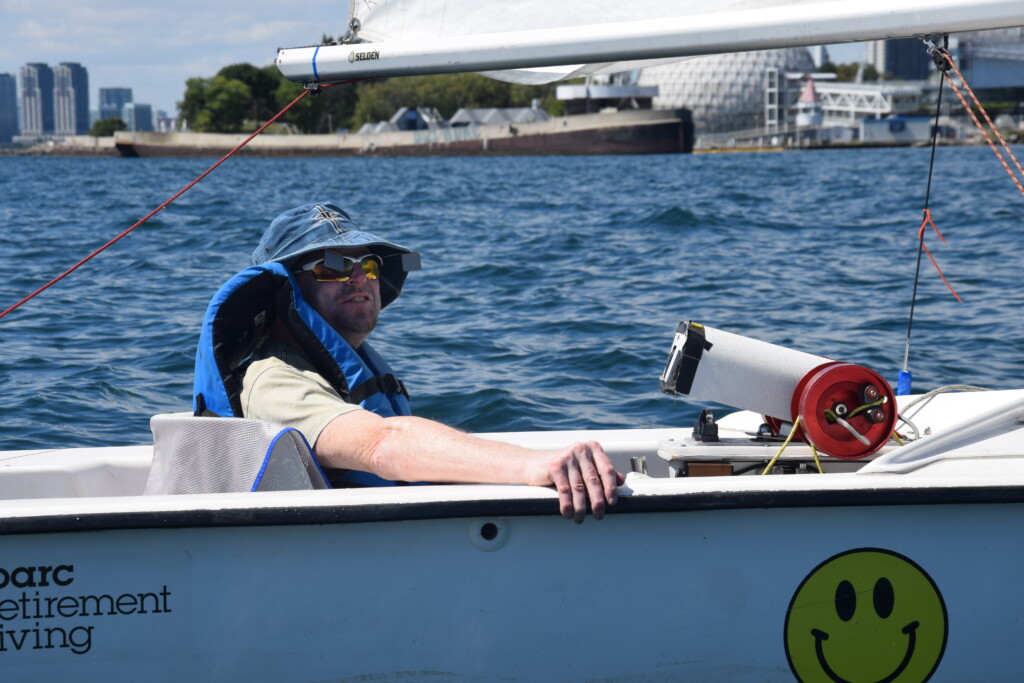
“I heard about the autohelm function, the electronic joystick. And yeah, and it was magic.”
From his early days on the racecourse, Burns was impressed at how the equipment was an equalizer. A pioneering adaptive surfer and previous Team Manager for Canada at the World Adaptive Surfing Championships, Burns has experience in other accessible extreme sports. But the inclusiveness of sailing, for someone with his condition, was unlike anything he had seen before.
Describing his first-ever national regatta, he recalls vividly “a gnarly, windy, grey day and a crowded start line,” with 20 boats clamoring for advantage at the start signal. The wind was howling, and his boat tilted so far over Burns could hardly see over the side of cockpit to gauge the location of his fellow competitors.
“All I could tell is there’s someone that’s right there because I can see their mast almost on top of mine,” he recalls.
“Then finally, the big-time wind calmed down enough to level the boat more and I could finally see […] and there’s René just sip and puffing right by me.”
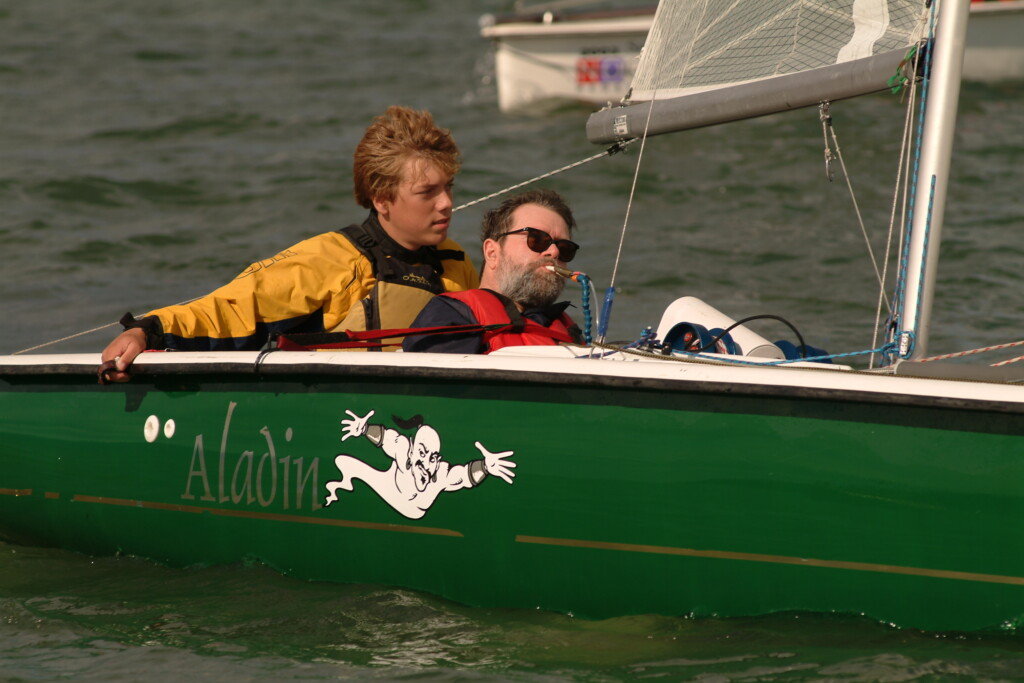
‘René’ being René Dallaire, founder of the Association Québécoise de voile adaptée, an adapted sailing program in Pointe Claire, Quebec, and one of the top sip and puff sailors in Canada.
In that moment, Burns realized the power of technology: everyone using different equipment and techniques to sail their own boat, but all with the same goal of winning. The equitable playing field offered by the technology is even more compelling considering that people with complex or multiple disabilities, including power wheelchair users, have very limited sport options. Athletes with complex disability can compete directly against their peers with much higher mobility or strength, or nondisabled competitors, and it’s the best sailor who will come out on top.
Off the racecourse, Burns has even bigger dreams about what sailing, and its inclusive technology can do for people to explore the world around them. For him, the Power-Assist means that “people can go and access nature and adventure in really different ways… [nature] is probably accessible to everyone if we support some of these opportunities.”
For Burns, that access means not just exploring the waters off Jericho Beach but exploring the world.
“I wish I could just sail all day… to explore and go beyond, to see new areas… I have these dreams to do overnight sailing, and offshore sailing.”
Burns is a go big or go home kind of guy, however he knows that everyone must start somewhere. His advice for coaches and leaders in sports who are looking to take the first step to fostering a more inclusive environment.
“If we can make sailing this adaptable to everybody, then virtually any other sport I’d think has got to be quite possible for everyone as well. I think if you have a sport you dream of, or that you love, look into it and even if you’re the first there’s people around that are happy to help you try and make it happen,” he says.
“Just create your own adaptations and you’ll be the next pioneer.”
Note: Recognizing that language about disability is deeply personal, nuanced, and ever-evolving, person-first (athlete with a disability, people with disabilities) has been used interchangeably with identity-first (disabled person). The athletes interviewed have been asked about their personal preference for how they are described.